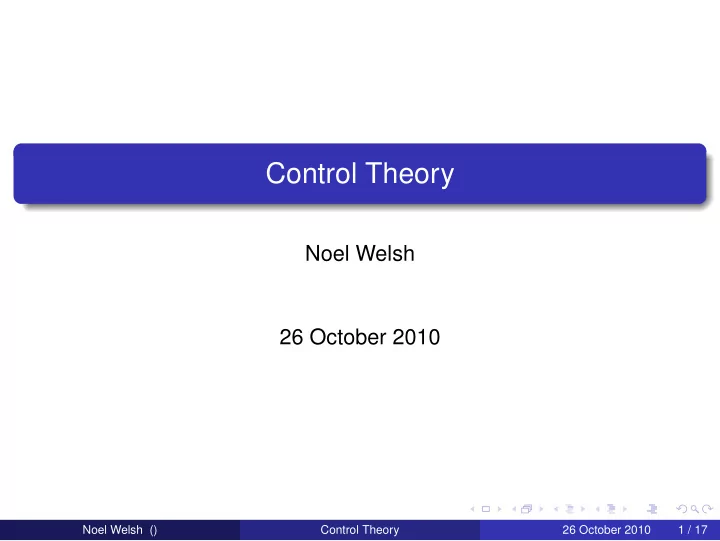

Control Theory Noel Welsh 26 October 2010 Noel Welsh () Control Theory 26 October 2010 1 / 17
Announcements Assignments were due on Monday, except for one team that has an extension. Marking will be delayed while we wait for this team to submit. Noel Welsh () Control Theory 26 October 2010 2 / 17
The Problem Control theory is concerned with making a (physical) system behave according to some specification. A controller is a device that attempts to do this. For example, a theromstat is a controller for a heating system that attempts to keep a room at a constant temparature. A microprocessor, appropriately programmed, can be a controller for a robot that drives the robot in a straight line. Noel Welsh () Control Theory 26 October 2010 3 / 17
How Would You Solve This? Assume you have one or more odometers on your robot, which give an accurate reading of the number of revolutions of each wheel. How would you make your robot drive in a straight line? Noel Welsh () Control Theory 26 October 2010 4 / 17
Three Types of Control Open loop Feedforward Feedback Noel Welsh () Control Theory 26 October 2010 5 / 17
Open Loop Control The simplest control is no control! Just plot a course before hand, close your eyes, and go! Some examples of open loop control: Most things that run on a timer are open loop control. Lawn sprinklers, for example, or lights, or washing machines. Rich people in this country believe in open loop control, as they will pay extra for a house with a fireplace. Noel Welsh () Control Theory 26 October 2010 6 / 17
The Problem of Open Loop Control Without some observation of the system under control any error can grow without bound! Noel Welsh () Control Theory 26 October 2010 7 / 17
Feedforward Control Feedforward modifies the control signal (e.g. the command to change motor speed) in a predetermined way, without reference to the behaviour that this control achieves. For example, your heart beat will increase in anticipation of exercise. Good if you have a detailed system model, or as an addition to feedback control. Noel Welsh () Control Theory 26 October 2010 8 / 17
Feedback Control In feedback control, the control signal is modified in response to the observed error in the behaviour. The most common kind of control. Three common variants: Proportional error (PE) Proportional integral (PI) Proportional integral differentation (PID) Noel Welsh () Control Theory 26 October 2010 9 / 17
Differentatial Equations Before we can understand PID control we have to understand (a bit of) differential equations A differential equation is an equation defined in terms of its derivative. v = v 0 + dv (1) dt Noel Welsh () Control Theory 26 October 2010 10 / 17
Calculus in One Slide The derivative of a function is its rate of change, or slope, or gradient with respect to some variable. E.g. if f is a function of x , we may ask about the derivative of f with respect to x . This is written df dx . One can take the derivative of a derivative, creating the second deriviative d 2 f dx 2 , and so on. Noel Welsh () Control Theory 26 October 2010 11 / 17
Equations of Motion Newton’s second law of motion is F = mdv (2) dt v is the velocity, m , the mass, and F is force. We normally call dv dx the acceleration . We can write equations of motion for all physical systems. Noel Welsh () Control Theory 26 October 2010 12 / 17
Electric Motors A compass spins to align with a magnetic field. If we can keep moving the magnetic field the compass will keep spinning. This is the principle behind electric motors. Noel Welsh () Control Theory 26 October 2010 13 / 17
Electric Motors: Details Inside the electric motor is a permanent magnet, and an electromagnet. The permanent magnet is fixed. The electromagnet can rotate. The current to the electromagnet is regularly flipped, and hence the polarity of the electromagnet changes. This flip is performed by the commutator and brushes working in tandem. Noel Welsh () Control Theory 26 October 2010 14 / 17
Electric Motor Equations of Motion T = Ki Torque is proportional to current e = K d θ dt EMF is proportional to rotational velocity J d 2 θ dt 2 + b d θ dt = Ki L di dt + Ri = V − K d θ dt J is the moment of inertia, b the damping ratio, L inductance, R resistance, V input voltage Noel Welsh () Control Theory 26 October 2010 15 / 17
First Order Lag Let x be the input, and y the output. A first order lag system satisfies c dy dt + y = x (3) Simple to analyse and control. Noel Welsh () Control Theory 26 October 2010 16 / 17
Second Order Systems Second order systems include the second derivative. Display oscillations. Hard to control. Does this mean electric motors are hard to control? Noel Welsh () Control Theory 26 October 2010 17 / 17
Recommend
More recommend